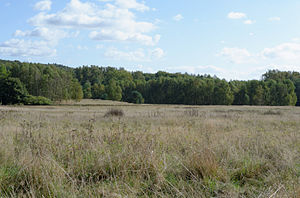Panten moor pond and surroundings
|
Panten moor pond and surroundings
|
||
|
Large dry grassland in the southern part |
||
| location | Northwest of Mölln , Duchy of Lauenburg district , Schleswig-Holstein | |
| surface | 147 hectares | |
| Identifier | NSG no. 173 | |
| WDPA ID | 164974 | |
| Geographical location | 53 ° 40 ' N , 10 ° 38' E | |
|
|
||
| Setup date | 2000 | |
| administration | LLUR | |
The Panten moor pond and the surrounding area is a nature reserve in the Schleswig-Holstein community of Panten in the Duchy of Lauenburg .
The approximately 147 hectare nature reserve is registered under number 173 in the directory of nature reserves of the Ministry of Agriculture, Environment and Rural Areas. It was expelled at the end of 1996 (date of regulation: December 20, 1996). The responsible lower nature conservation authority is the Duchy of Lauenburg district.
The nature reserve is located northwest of Mölln, west of the Elbe-Lübeck Canal . It consists of three sub-areas. The largest of the three areas is between Panten and Hammer. It forms the 89 hectare FFH area of the same name . The other two partial areas are between Neu-Lankau and Hammer directly on the Elbe-Lübeck Canal.
The nature reserve is located in a part of the Stecknitz meltwater channel, which was formed during the Ice Age . It turns in the core the Pantener Moorweiher and a mosaic of different habitats, including Sander tracts, quellige moraine -Steilhänge, open water, Verlandungs zones and breakage and source forests and dry and lean lawn in the region of a former soil extraction area in the partial area in hammer. The areas of the nature reserve were combined as part of a land consolidation process, taking into account the protection purpose. The trenches around the Pantener Moorweiher were sealed and the terrain rewetted , making around the Moorweiher a swamp with landscape sedge , wetland herb vegetation and willow bushes arose. A reed belt has spread out on the edge of the swampy area, and in some places quarry forest is growing. The remaining areas are occupied by wet to fresh pastures , some of which are structured by kinks . Slope areas are partly occupied by spring forest, species-rich beech forest and alder - ash forest. The area of the Stecknitzwiesen southwest of Neu-Lankau is occupied by wet meadows . In the direction of the Elbe-Lübeck Canal, parts of the reed beds, litter meadows and swamp forests are occupied. In the area of the former soil extraction area near Hammer, there are often dry locations with dry and poor grassland, heather and pioneering sand fields with few trees . Several small still water bodies have been created here due to earlier use .
Due to the different habitats, a large number of different animals and plants can be found in the nature reserve. So are u. a. Corncrake , bittern , Spotted Crake , red-necked grebe , little grebe , great crested grebe , marsh harrier , red-backed shrike and whinchat home here. White-tailed eagles and ospreys come as food guests, and great egrets can also be observed from time to time. Tree frogs and various dragonflies can be found in the damp areas . In 2018, 850 green toads were released in the nature reserve to build a new population. The dry, nutrient-poor locations in the area of the former soil extraction area were able to develop largely undisturbed after the end of use. They are the sand lizard's habitat . Various ground beetles and numerous species of bees and wasps can be found here, including sand wasps , beewolf , red-legged sand wasp, and dune sand beetle . In addition, the blue-winged wasteland insect and, among others, the plantain pied butterflies , hornet- glass-winged and sand strawflower owls are native here. The areas are also a retreat for specialized plants such as straw flowers , silver grass , feltwort and various lichens .
The nature reserve is largely surrounded by agricultural land . Natur Plus e. V. Panten looks after. The half-open pasture landscape around the Panten moor pond is grazed for maintenance. Parts of the nature reserve can be viewed from the edge of paths and from an observation platform. Only in the area of the former soil extraction area does a hiking trail run through the protected area. Information boards are set up in several places.
Web links
- Pantener Moorweiher and the surrounding area , leaflet from the State Office for Nature and the Environment of Schleswig-Holstein (PDF, 605 kB)
- The nature reserve Pantener Moorweiher and the surrounding area , Natur Plus e. V.
Individual evidence
- ↑ State ordinance on the nature reserve "Pantener Moorweiher and the surrounding area" of December 20, 1996 , state regulations and state case law, state government Schleswig-Holstein. Retrieved April 2, 2013.
- ^ Pantener Moorweiher and the surrounding area , profiles of the Natura 2000 areas, Federal Agency for Nature Conservation . Retrieved September 25, 2019.
- ↑ a b c Martina Kairies: NSG “Pantener Moorweiher und Umgebung” - 20 years nature conservation project - 10 years protected area - a positive development , annual report State Office for Nature and Environment of Schleswig-Holstein 2006/07 (PDF, 5870 kB). Retrieved May 6, 2019.
- ↑ a b The Pantener Moorweiher , Herzogs Naturschätze (PDF, 576 kB). Retrieved May 6, 2019.
- ↑ a b c Pantener Moorweiher nature reserve , Stecknitz-Post, 4/2017, pp. 1–2, TouristService Stecknitz-Region (PDF, 4.9 MB). Retrieved May 6, 2019.
- ↑ Joachim Strunk: Green toads released in the Panten moor pond , Lübecker Nachrichten , June 15, 2018. Accessed on May 6, 2019.
- ↑ A shining example to emulate, RZkultur. Retrieved April 2, 2013.
- ↑ Pantener Moorweiher: Half-open pasture landscape , Der Lämmerhof. Retrieved May 6, 2019.




